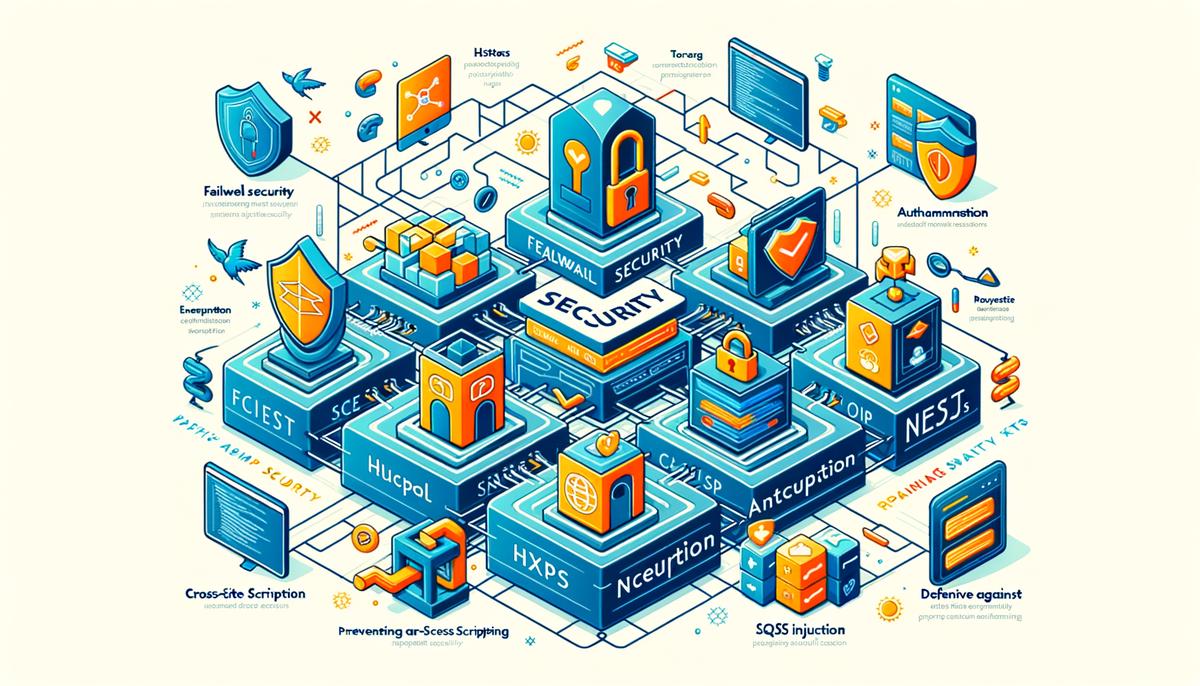
NestJS, the go-to framework for creating server-side applications that are both powerful and scalable, has unveiled exciting new updates. These enhancements promise to elevate development efficiency, performance, and the overall coding experience. In this exploration of the latest NestJS features, we aim to shed light on how these improvements can significantly impact developers and their projects.
Core Framework Enhancements
NestJS Latest Core Enhancements
NestJS, a popular framework used for building efficient and scalable server-side applications, recently introduced some pivotal core enhancements. These updates are designed to boost development productivity, enhance application performance, and provide a more seamless coding experience. Let’s dive into the key updates.
Performance Improvements
The latest version of NestJS has focused on optimizing the framework’s overall performance. By refining the underlying architecture, NestJS has significantly reduced the memory footprint of applications. This improvement means that applications built with NestJS now load faster and run more efficiently, which is crucial for handling high volumes of traffic.
Enhanced Type Safety
Type safety is a core aspect of NestJS, thanks to its support for TypeScript. The recent updates have taken this a step further. Developers can now enjoy stricter type checking and more intuitive TypeScript integration. This means fewer bugs and errors during the development process, as the enhanced type safety helps catch issues early on.
Hybrid Application Support
In an ambitious move, NestJS has introduced support for hybrid applications. This feature allows developers to create applications that can seamlessly transition between being a microservice and a standard web application. It’s a game-changer for projects that need to be versatile and adaptable without undergoing extensive rewrites or adjustments.
GraphQL Improvements
For applications leveraging GraphQL, NestJS has rolled out several improvements. The updates include better support for advanced GraphQL features like subscriptions and the latest enhancements in the GraphQL ecosystem. These improvements make it much easier to build and maintain robust, real-time APIs with NestJS.
CLI Enhancements
The NestJS CLI (Command Line Interface) is an essential tool for developers, and it hasn’t been left behind in the latest updates. The CLI now features improved schematics, making it easier to scaffold new projects and components. Plus, there are additional commands that streamline the development workflow, allowing developers to accomplish more tasks directly from the terminal.
Integrated Testing Utilities
Testing is crucial for any application, and NestJS has enhanced its built-in testing utilities. The updates make it simpler to write and execute tests, covering everything from unit tests to end-to-end testing. As a result, developers can ensure their applications are robust and reliable, with less effort spent on configuring and managing testing environments.
Conclusion
The latest core enhancements in NestJS mark a significant step forward for the framework. From performance improvements and type safety enhancements to support for hybrid applications and advanced GraphQL features, these updates solidify NestJS’s position as a leading choice for modern application development. As the framework continues to evolve, it’s an exciting time for developers working with NestJS.

New Middleware and Modules
NestJS, a popular framework for building efficient and scalable server-side applications, has been on the rise with its latest advancements in middleware and modules, promising more robust and flexible development capabilities. These enhancements cater to developers’ needs for more sophisticated and secure applications, fostering a streamlined development process.
One of the significant leaps forward is in the realm of security enhancements. With cyber threats becoming more sophisticated, the necessity for stronger security measures in web applications can’t be overstated. The new middleware advancements in NestJS introduce more comprehensive security features such as improved authentication mechanisms, better encryption practices, and advanced options for secure data transmission. This ensures that applications built with NestJS are not only fast and reliable but also secure from various cyber threats, providing peace of mind for developers and end-users alike.
In addition to security improvements, the modular approach of NestJS has been further refined. The framework now offers more granular control over modules, enabling developers to create more modular and maintainable codebases. This refinement in modules allows for better separation of concerns, making it easier to manage and evolve large-scale applications. For instance, the introduction of dynamic modules lets developers tailor the functionality of their applications more precisely, which was a sought-after feature among the developer community. This means that applications can be broken down into smaller, more manageable pieces that can be developed, tested, and deployed independently, leading to a more agile and efficient development process.
Another pivotal enhancement comes in the form of middleware configurability. The latest updates to NestJS middleware offer developers unprecedented control over how and where their middleware is applied. This configurability extends to the ability to dynamically modify middleware behavior based on the incoming request or application state, opening up opportunities for more intelligent, context-aware applications. Such flexibility was previously difficult to achieve and is a testament to the framework’s commitment to supporting complex, highly configurable web applications.
Moreover, the interactivity between middleware and modules has seen noteworthy improvements. Better mechanisms for communication and data sharing between different parts of an application mean that developers can write cleaner, more intuitive code. The improvements in this area not only make the developer’s job easier but also enhance the overall performance and scalability of applications built with NestJS. Improved inter-module communication leads to more efficiently structured logic and data flow within applications, which translates to faster response times and a better user experience.
In conclusion, the advancements in middleware and modules within NestJS mark a significant step forward for the framework, emphasizing its role as a leading choice for developing modern web applications. From heightened security measures and modular codebases to enhanced configurability and interactivity, these updates cater to a wide range of development needs, promising to streamline the workflow and elevate the quality of applications developed with NestJS. As the framework continues to evolve, it’s clear that NestJS is committed to providing developers with the tools they need to build flexible, efficient, and secure web applications.

Improved Security Features
NestJS, a progressive Node.js framework for building efficient and scalable server-side applications, has been consistently evolving, particularly in the realm of security — a paramount concern in today’s digital age. The latest updates and improvements in NestJS security features signify a giant leap forward, ensuring applications are not only robust but also resilient against cyber threats.
Rate Limiting for Enhanced Security
: NestJS has introduced a new feature known as rate limiting. This critical security feature helps prevent denial-of-service (DoS) attacks by limiting the number of requests a user can make to an API within a certain timeframe. By incorporating rate limiting, NestJS ensures that applications remain accessible and performant, even under heavy user load or during an attack.CSRF Protection Mechanisms
: Cross-Site Request Forgery (CSRF) attacks have been a concern for web applications, tricking users into executing unwanted actions on a web application in which they’re currently authenticated. NestJS has bolstered its defenses by integrating CSRF protection mechanisms directly into the framework. Developers can now easily enable CSRF protection, adding an extra layer of security against such attacks.Role-Based Access Control (RBAC)
: With the latest updates, NestJS has enhanced its support for Role-Based Access Control (RBAC). This feature allows developers to define roles and permissions within their applications, ensuring that users can access only the data and actions that are appropriate for their roles. RBAC in NestJS is both flexible and granular, enabling developers to implement sophisticated access control policies with ease.JWT Improvements
: JSON Web Tokens (JWT) are a popular method for handling authentication and authorization in web applications. NestJS has made significant improvements to its JWT functionality, making it more secure and easier to implement. These improvements include better token validation, enhanced encryption methods, and streamlined processes for token refresh, providing a secure and user-friendly authentication experience.Helmet Integration for Secure Headers
: NestJS has integrated Helmet, a middleware that sets various HTTP headers to secure applications from common vulnerabilities. By default, Helmet adjusts HTTP headers to protect against well-known web vulnerabilities such as clickjacking, sniffing attacks, and cross-site scripting (XSS). This integration means developers can easily enhance the security of their applications without needing in-depth knowledge of specific web vulnerabilities.Secure Cookies Implementation
: Handling cookies securely is paramount in protecting user data and ensuring the security of web applications. NestJS has introduced improvements to how cookies are managed, allowing developers to set secure flags, HttpOnly flags, and same-site attributes with ease. These enhancements make it more challenging for attackers to intercept or manipulate cookies, thereby securing user sessions.The strides NestJS has made in enhancing its security features underscore its commitment to providing a secure framework for developing server-side applications. By focusing on rate limiting, CSRF protection, RBAC, JWT improvements, Helmet integration, and secure cookies implementation, NestJS developers can build applications that not only perform well but are also fortified against an array of cyber threats. These enhancements, paired with the framework’s ongoing commitment to security, make NestJS an even more compelling choice for developers prioritizing application security.

Community and Ecosystem Growth
Continuing to explore the transformative journey of the NestJS community and ecosystem, we delve into several key advancements that have significantly contributed to its growing popularity among developers. As a scalable, versatile framework designed for building efficient and reliable server-side applications, NestJS continues its evolution, focusing on simplifying backend development while embracing modern technologies.
Community Growth and Contributions
NestJS has witnessed an exponential increase in its community size. This vibrant and dynamic community plays a pivotal role in the ecosystem’s evolution, offering a plethora of plugins, libraries, and tools that enhance functionality and streamline the development process. Open source contributions have led to the refinement of existing features and the introduction of novel solutions, ensuring developers have access to a rich set of resources tailored to diverse project requirements.
Embracing Full-Stack Development
A remarkable trend in the NestJS ecosystem is its growing support for full-stack development. By seamlessly integrating with popular frontend frameworks like Angular, React, and Vue, NestJS is fostering an environment where developers can manage both client and server-side code within a unified platform. This convergence simplifies the development workflow, enhances productivity, and caters to the increasing demand for full-stack expertise in the job market.
Educational Resources and Developer Support
Education and support mechanisms have significantly improved, with an abundance of tutorials, documentation, and community forums available. These resources assist developers in overcoming challenges, learning best practices, and staying updated with the latest features and trends. Workshops, webinars, and conferences further facilitate knowledge sharing and networking, encouraging innovation and collaboration within the community.
Continuous Improvement and Updates
The NestJS team is committed to continuous improvement, consistently releasing updates that address bugs, improve performance, and introduce cutting-edge features. This dedication ensures that the framework remains robust, secure, and aligned with the evolving needs of modern web applications. Regular updates also reflect the project’s long-term vision and reliability, instilling confidence among businesses and developers alike.
Expansion of Official Modules
The official modules provided by NestJS have seen significant expansion, covering a broader range of functionalities. From real-time capabilities with WebSockets to microservice architectures, these modules offer developers pre-built, customizable solutions that simplify complex implementations. The growing library of modules underscores NestJS’s versatility, catering to a wide array of application types and business needs.
Conclusion
The evolution of the NestJS community and ecosystem is a testament to its adaptability, resilience, and commitment to excellence. With an unwavering focus on developer experience, performance, and security, NestJS continues to shape the future of server-side development. As it embraces new technologies and patterns, the framework opens up a realm of possibilities for developers, empowering them to build high-quality, scalable applications with ease. The journey of NestJS is far from over, with each advancement paving the way for more innovative and efficient development practices.

As we look at the spectrum of updates brought by NestJS, it’s clear that the framework is not just evolving; it’s truly revolutionizing the way developers create server-side applications. With its focus on performance, security, and developer-friendly features, NestJS redefines efficiency and robustness in application development. These advancements not only reinforce NestJS’s position as a leader in the development realm but also promise an empowering pathway for developers aiming to build the next generation of scalable and reliable applications.


